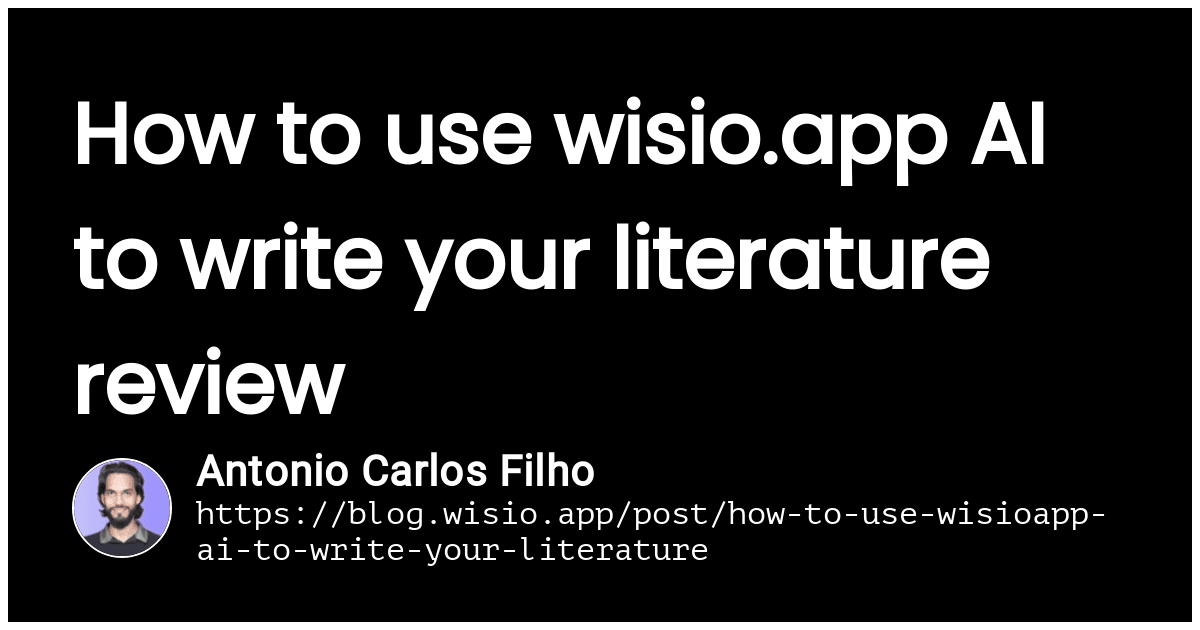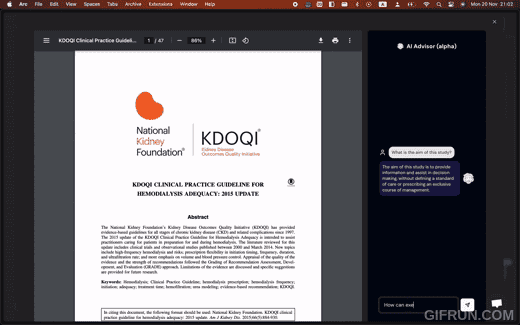How to use wisio.app AI to write your literature review

Writing an effective introduction is crucial for setting the tone and context of your literature review. It serves as a roadmap for your readers, providing them with an overview of your topic and the purpose of your review. In this section, we will explore the key elements and strategies to craft a compelling introduction for your literature review.
Using AI Advisor to suggest you a topic
One of the first steps in writing your literature review is selecting a topic that is relevant, interesting, and aligns with your research interests. wisio.app AI offers a powerful tool called AI Advisor that can assist you in this process. In this section, we will explore how to effectively utilize Advisor AI to suggest a topic for your literature review.
Click on the floating widget and the AI Advisor chat will popup. Ask a question like:
Suggest me a topic for a literature review about ants and climate change.
The, AI Advisor will promptly answer you with a topic for you to start researching and writing. You can also upload a PDF using the Magic Mode, and then, ask questions about the context of the PDF using the AI Advisor.

Write your introduction
Now that you decided your topic with the help of Advisor AI, let's start writing your Introduction. Open wisio.app's editor and let's get going.
1. Start with a hook
Begin your introduction with an attention-grabbing statement or anecdote that piques the reader's interest. This could be a thought-provoking question, a surprising statistic, or a compelling story related to your topic. By starting with a hook, you can captivate your audience and encourage them to continue reading. You can ask our AI Advisor for a suggestion, or, start writing some lines and ask for a AI Suggestion.

2. Provide background information
After capturing your readers' attention, provide them with some background information about your topic. This could include a brief overview of the field of study, the significance of the research area, and any relevant historical or theoretical context. By providing this background information, you establish the relevance and importance of your literature review.
3. State the purpose and objectives
Clearly articulate the purpose and objectives of your literature review. State the specific research question or problem that your review aims to address. This helps to establish the focus and scope of your review and informs readers of what they can expect to find in your analysis.
4. Outline the structure of your literature review
After stating the purpose and objectives, provide an outline of the structure of your literature review. Briefly mention the main sections or themes that you will be covering, giving readers a roadmap of what to expect in the following sections. This helps to create a logical flow and guides readers through your review.
5. Highlight the significance and contribution
Conclude your introduction by highlighting the significance and contribution of your literature review. Explain how your review fills a gap in the existing research, advances the knowledge in the field, or provides a new perspective on the topic. By emphasizing the importance of your review, you engage readers and demonstrate the value of your work.
Remember, an effective introduction should be concise, engaging, and informative. It should provide a clear overview of your topic, establish the purpose and objectives of your review, and entice readers to continue reading. With a well-crafted introduction, you can set the stage for a comprehensive and impactful literature review.
Getting references
Once you have selected a topic for your literature review, the next step is to gather relevant references to support your analysis and strengthen the credibility of your review. In this section, we will explore the various methods and resources you can use with wisio.app AI to obtain high-quality references for your literature review.
It's very simple and straightforward, just select any text and click on the Find References button on the right panel. This will automatically prompt our AI to search for the best and most references for your selected text on Pubmed and Crossref.

Conclusion
In conclusion, utilizing wisio.app AI to write your literature review can greatly enhance the efficiency and effectiveness of the writing process. The various features and tools offered by wisio.app AI, such as Advisor AI for topic suggestions, the reference database for gathering credible sources, AI completions for generating well-structured paragraphs, and guidance in maintaining an academic tone, provide valuable support throughout the entire process.
By leveraging Advisor AI, you can save time and effort in selecting a topic that aligns with your research interests and is relevant to your field of study. The reference database enables you to access a wide range of scholarly sources, ensuring that your literature review is based on sound and reputable research. The AI completions feature assists in enhancing the clarity and flow of your writing, making your literature review more coherent and engaging.
Furthermore, by following the strategies and techniques to maintain an academic tone, such as using formal language, properly structuring your review, citing and referencing accurately, incorporating critical analysis, and paying attention to formatting and presentation, you can ensure that your literature review meets the standards of academic writing.
Overall, wisio.app AI provides a comprehensive and efficient platform for writing your literature review. By utilizing the various features and tools, you can streamline the writing process, enhance the quality of your review, and produce a well-crafted and academically sound piece of work.
Remember, while AI can provide valuable assistance, it is important to exercise critical thinking and consult with your academic advisor or mentors throughout the writing process. Their guidance and expertise will further enrich your literature review and ensure its success.
So, embrace the power of wisio.app AI and let it guide you in writing an exceptional literature review that contributes to the knowledge in your field and showcases your academic abilities.
